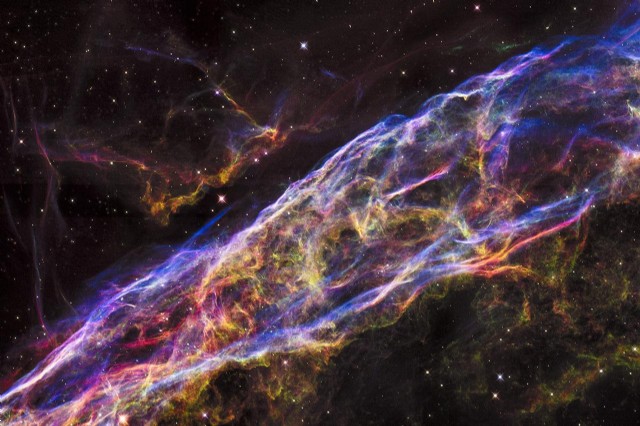Dying Swan Tale Unveiled Poem by Harley White
Dying Swan Tale Unveiled
A stardust veil in resplendent detail
is with multicolors imbued
from astral blast leaving Cygnus aghast
in the stunning spectacle viewed.
Supernova boom made stellar winds zoom
into beauteous wispy guise
as swan song story, whose gorgeous glory
its violent dawning belies.
This picturesque cloud of filament shroud
concealing a cavity wall
interacts and behaves through shocking waves
like a vast repercussive sprawl.
The varied tones in the nebula's zones
come from chemic denseness changes;
plus hotter are blue, while green or red hue
indicates the cooler ranges.
That huge display many light-years away,
two thousand one hundred in fact,
covers six full moons of skyey festoons
with its striking unveiling act.
In rainbowlike stream from the Hubble team
which shows but a part of the whole,
what was once a star exploding afar
is cast in sensational role.
Some gassy fumes were emitted in plumes
before its chromatic demise
of curtain splendid until it ended
with mosaic to mesmerize.
Might this veil in Cygnus grand in bigness
evoke in the senses instead
thoughts of feathers chiffon as spectral swan
whose delicate essence has fled?
Those exquisite arts that have stirred our hearts
and heightened awareness inspired,
as has stargazing at skies amazing,
for centuries have been admired.
In Tennyson quote from verses he wrote,
all ‘the marish-flowers that throng'
with coronach styled by silver swan wild
‘were flooded with eddying song'.
Poems live on after poets are gone,
at any rate masterpieces
outlast their creators or narrators,
follies and human caprices.
The airborne creature in ballet feature,
that Anna Pavlova rendered,
through faltering breath to quivering death
the most swanlike e'er engendered,
was classic in scope plus a timeless trope
for our fleetingly mortal span
and toils on earth to endow it with worth
in our frame of woman or man.

Called the Veil Nebula, the debris is one of the best-known supernova remnants, deriving its name from its delicate, draped filamentary structures. The entire nebula is 110 light-years across, covering six full moons on the sky as seen from Earth, and resides about 2,100 light-years away in the constellation Cygnus, the Swan.
This view is a mosaic of six Hubble pictures of a small area roughly two light-years across, covering only a tiny fraction of the nebula's vast structure.
This close-up look unveils wisps of gas, which are all that remain of what was once a star 20 times more massive than our sun. The fast-moving blast wave from the ancient explosion is plowing into a wall of cool, denser interstellar gas, emitting light. The nebula lies along the edge of a large bubble of low-density gas that was blown into space by the dying star prior to its self-detonation.
* * * * * * * * *
The Dying Swan (originally The Swan) is a solo choreographed by Mikhail Fokine in 1905 to Camille Saint-Saëns's Le Cygne from Le Carnaval des animaux as a pièce d'occasion for the ballerina Anna Pavlova, who performed it about 4,000 times. The short ballet (4 minutes) follows the last moments in the life of a swan, and was first presented in St. Petersburg, Russia in 1905. The ballet has since influenced modern interpretations of Odette in Tchaikovsky's Swan Lake and has inspired non-traditional interpretations and various adaptations.
Inspired by swans that she had seen in public parks and Alfred, Lord Tennyson's poem 'The Dying Swan', Anna Pavlova (who had just become a ballerina at the Mariinsky Theatre) asked Michel Fokine to create a solo for her for a 1905 concert being given by artists from the chorus of the Imperial Mariinsky Opera. Fokine suggested Saint-Saëns's cello solo, Le Cygne (which Fokine had been playing at home on a mandolin to a friend's piano accompaniment) and Pavlova agreed.
* * * * * * * * *
Image: The Veil Nebula was observed by the NASA/ESA Hubble Space Telescope. Image released Sept.24,2015.
Credit: NASA, ESA, Hubble Heritage Team
This poem has not been translated into any other language yet.
I would like to translate this poem